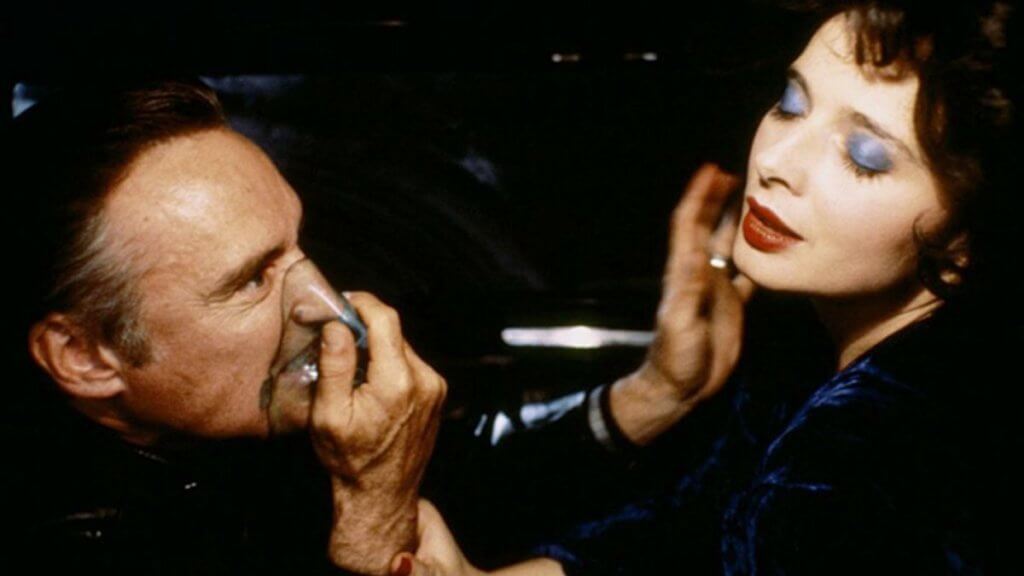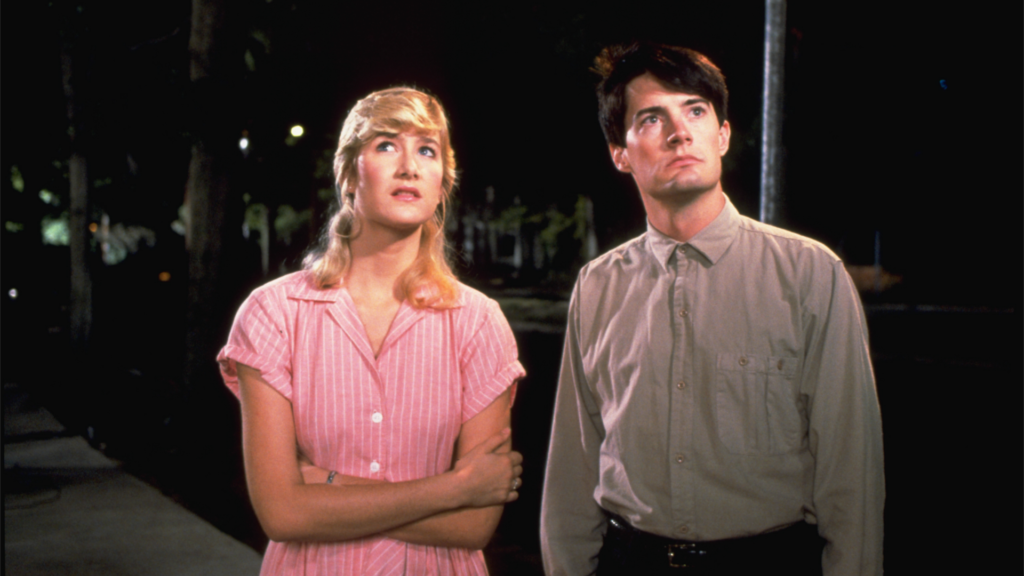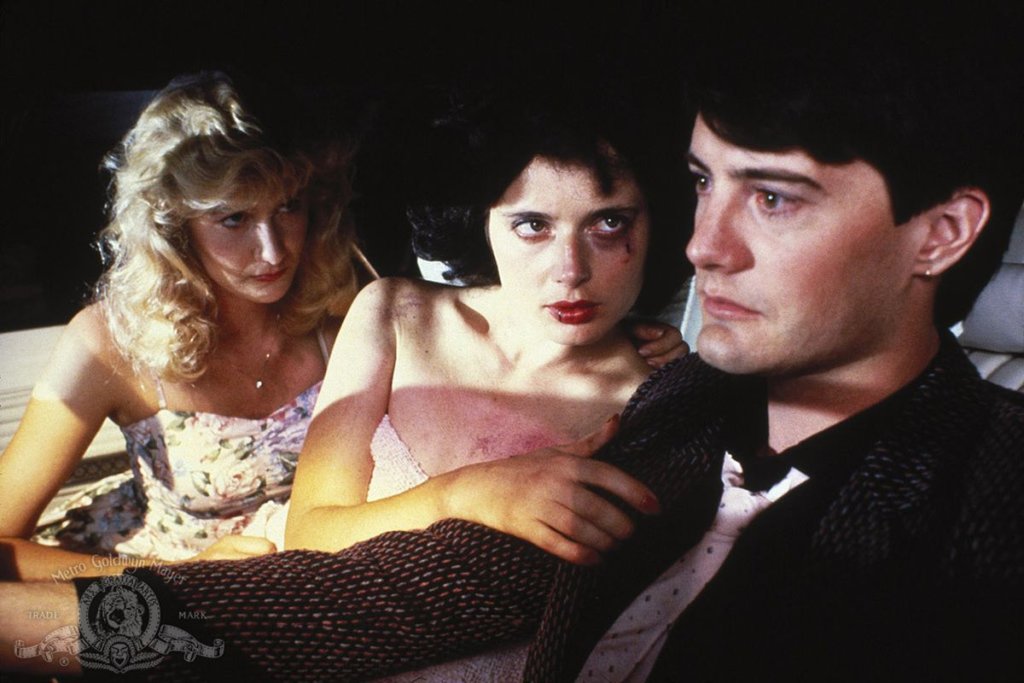Blue Velvet Movie He Put His in Me
Think of the most controversial films of the last few years. Drive certainly fit the bill for 2011, in both its lack of action sequences and its viewers' anti-Semitic readings of the film. In 2010, people were equally turned off and enamored with Scott Pilgrim vs. the World, choosing different readings of its adolescent heroes and their blatant immaturity. And in 2009, despite its critical acclaim, there were understandable reservations surrounding Quentin Tarantino and his alteration of history and (big surprise) portrayal of violence in Inglourious Basterds.
Frankly, these "controversies" all seem like chump change compared to Blue Velvet, which was so divisive in 1986 that people were practically drawing lines in the sand, claiming the film to either be an instant classic or a stylized piece of trash.
Ebert gave it one of his infamous one-star reviews, claiming Lynch's portrayal of woman (especially of Dorothy) was far too sexually blunt and detracting to allow Blue Velvet to be anything more than a misogynistic outing. It was labeled as "cult", which (much like Drive) meant it wouldn't attain a "legendary" status outside of its minimal followers for years, while also suggesting that its subject matter was far too dark and deep to be understood outside a select audience.
What connects all these divisive films isn't their gruesome depictions of violence or any level of irresponsibility, but instead their capture of the fantastical. Steeped in reality through their settings, each film is often misinterpreted as everything but a romantic piece of extravagance. Perhaps it's these fantastical tales' attention to raw human emotion that throws viewers off—a merging of fantasy and reality elements, causing people to throw out the "stylized piece of trash" phrase.

As most of David Lynch's films are gigantic metaphors for the darker side of American ideals, it's no surprise that almost all of his films are met with a collective reservation from audiences. Lynch himself called Blue Velvet "a dream of strange desires wrapped inside a mystery story," signaling that much of what occurs in Blue Velvet isn't reality, but a desire—a pure nostalgia for the past. It's this key motif of focusing on nostalgia that gives emotional weight to all of the elements viewers believe are drawbacks about the film: the portrayal of women, the bluntness of violence, and the radical portraits of American life from both ends of the spectrum.
In dissecting our collective nostalgia for the past, Lynch very much utilizes these "detractors" as enhancers, focusing on their extremes and offsetting contradictions to capture the romantic danger lying beneath nostalgia. In each of these seeming drawbacks, Lynch pairs the past with the present, revealing the dark days of youth, society's not-so-glamorous consumption of women through culture, and the gripping reality of the American Dream.
The first important thing to realize is how each character is offset by another. Jeffrey (Kyle MacLachlan), who speaks of virtues and cries about the cruel dark underbelly of society, essentially becomes a sexually abusive fiend like Frank (Dennis Hopper). And while Sandy (Laura Dern) is a stylized, sexualized evocation of the "dream girl", Dorothy (Isabella Rossellini) is a raw, unglamorized portrait of reality's worst outputs. Such contrasts carry into the overall juxtaposition within the film, pairing the real and the fantastical side by side, integrating into one another and forming an alternate reality that feels debilitatingly honest. At two points in this film, each Jeffrey and Sandy make astute, yet naïve-sounding observations of their surroundings that offset their dreamlike nostalgia for the past. Jeffrey cries as he begs, "Why are there people like Frank?" Sandy makes a much more romantic statement in response to Jeffrey's cry, saying:
"I had a dream. In fact, it was on the night I met you. In the dream, there was our world, and the world was dark because there weren't any robins and the robins represented love. And for the longest time, there was this darkness. And all of a sudden, thousands of robins were set free and they flew down and brought this blinding light of love. And it seemed that love would make any difference, and it did. So, I guess it means that there is trouble until the robins come."
Summing up the meaning and connection of these two statements in an interview with David Chute, Lynch said of Blue Velvet: "It's like saying that you've once discovered there are heroin addicts in the world and they're murdering people to get money—can you be happy? It's a tricky question. Real ignorance is bliss."

While Sandy represents the blissful ignorance, Jeffrey's journey into Frank's world represents the depressing actuality of American society he so desperately attempts to assign meaning. We see Jeffrey finally succumbing to Sandy's way of thinking in the film's closing moments, as he and she look upon a robin eating a worm—a small depiction of violence and nature that bookends Lynch's film. Sandy and Jeffrey chuckle simultaneously about the bird, noting, "It's a strange world, isn't it?" Blocking out the apparent violence at hand and offhandedly chalking it up to nothing more than nature at work, we see, once again, these two escaping into blissful ignorance and recapturing their endearing nostalgic views of the past, before the police investigation obliterated them. It's a rounding out of dreams evoking nostalgia, as Jeffrey ventures into the police investigation with a quizzical mindset that recalls "The Hardy Boys" or "Encyclopedia Brown", only to discover its horrors, and then subsequently bury those fears and relish in life's simplest wonders.
With fantasies of the past merging with the present, the contrast between Jeffrey and Frank is one that calls out the rebellious generation of youth that, in turn, came to influence future generations. Like in many of Lynch's films, music is employed to stylize, but never has it been more integral to the motif at hand than in Blue Velvet. Building atmosphere is certainly key, as seen in the stark contrast between car rooftop dancing along to Roy Orbison's "In Dreams" and Jeffrey's beating, but the overall (and in this scene, direct) message rock music carries in Blue Velvet is one that recalls the finer, less endearing aspects of youthful rebellion.
Frank, enamored by Ben's (Dean Stockwell) rendition of "In Dreams", attaches a sick sense to the past. The drugs, the sexual desire, and the domination of women all recall the more unruly aspects of rock music, and when reenacted verbatim in one's life become a gripping portrayal of alienation from society's norms, attaching a double meaning to our (and Jeffrey's) attachment to classic ideals. Frank represents the bane of a contradicting system, which reminisces of a fonder lifestyle, while never accounting for the reality of such a lifestyle. As Frank beats Jeffrey in an open field, he begins to sing Orbison's song:
"I close my eyes, then I drift away/Into the magic night, I softly say/A silent prayer like dreamers do/Then I fall asleep to dream my dreams of you."
This very song embodies what Lynch's central message comes to be, in the end contradicting itself:
"But just before the dawn/I awake and find you gone/I can't help it, I can't help it, if I cry/I remember that you said goodbye"
Frank begins to cry upon singing these lines, displaying his fading grip on the past and the desperateness in retaining the beautiful dream it once presented to him before lurching him into such a dark world. Being a fantastical film, nothing about Frank's literal descent into such a system is to be seen as reality, but the reality of the metaphor reveals the danger in aspiring to such a lifestyle. The danger in attaching oneself to the past. The danger in becoming a product of someone else's vision or message—which Jeffrey very much becomes.
Frank's small arc very much represents what Jeffrey experiences in Blue Velvet's entirety, but his short stint in the film displays all the horrors in full force to offset Jeffrey's wondrous mindset. So while his touchy relationship with Sandy charmingly recalls a Sixteen Candles-like innocence to young love, Jeffrey's beating of Dorothy is starkly honest, representing his integration into Frank's system. For Jeffrey it's more of a brief glimpse, living out the darkness he proclaims to not understand in an unrelenting moment of self-discovery. In so desperately aspiring to understand a dark system that he once viewed romantically, Jeffrey's transformation into a misogynistic beast shapes a striking parallel between the reality of this fantasy world and the reality outside Blue Velvet.
Amidst such a transformation the most controversial aspect of Lynch's film comes to light: the objectification of women. Keeping in line with Jeffrey's descent into Frank's world, the balance between Sandy and Dorothy creates a contrast in how women are viewed in society, which in turn stems from the male-domineered system roused from Jeffrey's journey. Sandy represents the traditional allure of a young woman, attractive through her light sexuality and blissfully oblivious view of natural order, while Dorothy represents the opposite end of the spectrum:a palpable and unmitigated display of unglamorized nudity. Such a gripping display offsets the moment we first witness Sandy, emerging from the darkness cloaked in a ray of light, accompanied by an arousing chorus. The sense of nostalgia in this case falls back upon the traditional view of the "girl next door", offset by Dorothy, who, like Frank, is the upchuck of a crippling American system. Dorothy beautifully sings "Blue Velvet" on stage:
"She wore blue velvet/Bluer than velvet was the night/Softer than satin was the light"

A portrait of innocent adoration on Jeffrey's part, the image of Frank looking pitifully upon Dorothy reveals the danger in attaching oneself to such nostalgia. Frank bites down on a blue piece of velvet as he rapes Dorothy, shaping her surrender to Jeffrey's manhood into a display of lost cause in such a system. Begging to be beaten, a seeming display of reality is actually a fantastical way of relating the progressively demeaning subjugation of women, while never abandoning the incredibly real sense of trauma that shapes Dorothy and Jeffrey as human beings, and also plagues our deepest fears regarding our selves and what we're capable of.
Dorothy becomes a piece of symbolism utilized by Lynch with the same level of objectification as a Playboy centerfold, putting women on display to satisfy the egos of men. For Jeffrey's glamorous view of Sandy and the American dream—which he blissfully accepts after abandoning Dorothy—puts such a nostalgia on display in the film's final moments, evoking the classic tale of men coming home to their expecting wives. Except, as seen in many films, Jeffrey toes the line of morality and alters between romantic and beast, only to become a traditional hero in the end.
The opening scene of Blue Velvet features several shots of the American Dream at work, cycling through the 1950s up to the 1980s. Each shot represents a different extremity of its respective decade, featuring various car models and television shows, and each shot is bathed in red roses and white picket fences. It gives the melancholic color of blue a striking presence in Jeffrey's journey, offsetting the nostalgia of the American Dream in the subtlest way amongst Lynch's giant metaphor.
The desire for such a dream is rewarded to Jeffrey and Sandy in the end, but it comes at the cost of their innocence. For its clear that no person can exist in this world without living through its faults and horrors, and such an abandonment of reality leads to the blissful ignorance on display in the final shot. As Jeffrey smiles we believe he is truly happy, but accompanied with the gruesome images from Frank's world and what Jeffrey succumbed to, we surely recognize the taste of bittersweetness lying beneath such blind acceptance.
Blue Velvet isn't a tale of morality or a preachy proclamation, but instead a very real depiction of the danger in attaching oneself to nostalgic dreams. Utilizing Jeffrey's shift through experiencing such nostalgia firsthand evokes what David Lynch does best: taking our deepest fears and weaknesses and putting them on display through a system that doesn't feel sprawling, but instead constricting, suffocating, and altogether encompassing in the most honest and humane ways possible.
Source: https://filmcolossus.com/single-post/2016/10/24/The-wonders-and-horrors-of-nostalgia-in-BLUE-VELVET
0 Response to "Blue Velvet Movie He Put His in Me"
Post a Comment